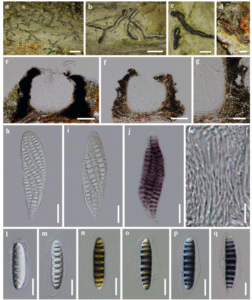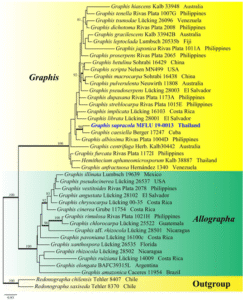Graphis supracola A.W. Archer, Aust. Syst. Bot. 14(2): 267 (2001)
Index Fungorum number: IF 483622; MycoBank number: MB 483622; Facesoffungi number: FoF 06021; Fig. 34
Thallus corticolous, whitish or greyish white, smooth or slightly roughened, ecorticate, dull. Lirellae erumpent to prominent, with lateral thalline margin, no striation, short and stellately or irregularly branched, up to 4 mm long, libia convergent, white pruinose, disc concealed in dry material, nearly exposed of section in water. Excipulum lateral carbonized, black, brown in thin section. Hymenium clear. Asci 96–112 × 21–31 µm, 8-spored, clavate. Ascospores 25–50 × 6–9 µm (x̅ = 35.1 × 7.6 µm, n = 34), mostly 30–40 µm long, overlapping or tri-seriate, hyaline, clavate to ellipsoid with rounded ends, transversely 7–11-septate, with lens-shaped lumina and gelatinous sheath, I + yellow to blue or violet.
Chemistry: KOH–; Thallus P + orange (Fig. 34d), protocetraric acid.
Material examined: THAILAND, Chiang Rai, on decayed wood in a mountain roadside forest, 20 June 2018, Y.S. Liu, L02 (MFLU 19-0013).
GenBank numbers: mtSSU: MK770352; nuLSU: MK770351.
Notes: Graphis has 390 species and only a few have been sequenced. According to a world-wide key to the genus in Lücking et al. (2009) and a key for recorded Graphis species in Thailand (Kalb et al. 2018), the new collection resembles G. supracola (Archer 2001) as both contain protocetraric acid (P + orange, K–). G. supracola has been reported from Africa (Joshi et al. 2016), Australia (Archer 2001), Cambodia (Moon et al. 2013), Thailand (Poengsungnoen et al. 2010; Schumm and Aptroot 2012), USA (Seavey and Seavey 2011) and Vietnam (Joshi et al. 2013). It is very common in Thailand but there is no available sequence data (Kalb et al. 2018). The morphological characteristics of our collection fit those of G. supracola (Kalb et al. 2018). The new collection has larger ascospores than previously described for G. supracola (25–40 × 6–8 μm), which is well-characterized in having concealed disc (caesiella-morph). Herein, we provide reference sequences for G. supracola, and a phylogenetic analysis based on mtSSU and nuLSU sequence data of Graphis species (Fig. 35). G. supracola and G. caesiella are closely related in the phylogenetic tree, but they form distinct lineages with high statistical support and differ mostly in the chemistry

Fig. 34 Graphis supracola (MFLU 19 − 0013, a new sequenced species). a − c Habitus. d. Thallus with P + orange. e − f Vertical section through an ascoma. e Thick section, excipulum black. f Thin section, excipulum looks brown. g Structure of excipulum in thin section. h − j Ascus; j Ascus in Melzer's reagent. k Hymenium, clear. l − q Ascosproes; l − m Ascospores in water. n − p Ascospores in Lugol's iodine, which present yellow to blue. q Ascospore in Melzer's reagent which presents violet. Scale bars: a = 1 mm, b = 500 μm, c,d = 200 μm, e − f = 50 μm, g − j = 20 μm, k − q = 10 μm

Fig. 35 Phylogram generated from maximum likelihood analysis based on a combined mtSSU and nuLSU sequence dataset in the tribe Graphideae (subfamily Graphidoideae). Redonographa chilensis (Tehler 8407) and R. saxiseda (Tehler 8370) in the subfamily Redonographoideae were used as outgroup. Bootstrap values for maximum likelihood (ML) ≥ 75% are placed above the branches. Branches with Bayesian posterior probabilities (PP) ≥ 0.95 are in bold. The newly generated sequence is indicated in blue
